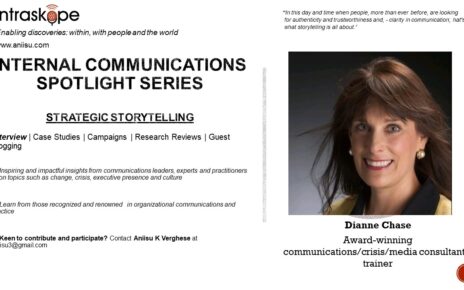Welcome to the 2nd episode of Intraskope’s Spotlight Series featuring Peter Yorke.
How do communicators develop and demonstrate executive presence? Do communications and personality types play a role? What are the key aspects to getting a seat at the table and driving results? Learn more in this interview I did with Peter Yorke. He discusses the ability to understand your audience, take people along, add value and align communications with business goals. Peter is an award-winning marketing and communications leader with over 32 years of experience in branding, corporate communications, high-tech public relations, training and strategic consulting. Currently, he serves as the SVP of Marketing at SunTec Business Solutions. Peter ran his own content marketing organization earlier. I have had the honor of working with him at i-flex solutions where we designed and implemented some cool award-winning employee communication initiatives and channels.
Peter argues for leaders and communicators to be taken seriously by building executive presence. This happens when you invest in garnering trust through consistent delivery of results and staying true to your word. It is about having a ‘mindshare’ among stakeholders and managing them effectively.
“Communications is at the heart of any business. Ultimately, you can make or break a business with or without your communications, but it becomes very important for us to ensure that not only are we heard internally, but they’re also heard externally. We need to occupy a mindshare with stakeholders because when they’re doing the conversations, be it one on one with the customer or be it one to many at a conference or be it across a board meeting, they need to reflect the communication mandate that we are trying to drive in a company”, says Peter.
About Intraskope’s Spotlight Series
In this series I interview key thought leaders on topics interrelated with internal communications such as culture, crisis, change, executive presence and leadership. The goal is to help unravel why they matter, what can leaders and communicators learn from experts and how we can put insights to practice. Watch these short interviews and get better at understanding these key topics and how you engage with internal communications.
Interview:
- How do you describe executive presence?
I describe executive presence as not just words, but more importantly deeds. And when I say deeds, what I mean is that, if today we’re talking about driving up the value of the company from a brand perspective, what we’re talking about is delivering a consistent message across employees, or generating leads for the company that has to be manifested by hardcore numbers or results, For example, a few months back, we charted for ourselves a mandate of how we would go about doing our communications. Especially, what are the three or four elements we would anchor our communications on and which will drive business results for the company. I did a performance plan for four months and what do we achieve. A lot of foundational work needed to be done. Then, now we reach the next stage. So now we are looking at the next four or five months, and we are saying, what do we do, for the next period, what do we achieve. And what we did across those four months is, even as we kind of crossed milestones. Okay, we kept the stakeholders, informed of what we’ve done. So, people can see momentum. They see things are happening, it becomes infectious. Tell them what we’ve done so we have a status update to the formal meeting. It’s just 45 minutes, but we share a presentation where I tell them what we have done. Also tell them what is not done and tell them what we have left, what are the dependencies. Sometimes the dependencies could be on them right they haven’t gone ahead with something or the other, so we go through the process, every week.
2. How important is it for leaders and managers to focus on building executive presence?
Communications is at the heart of any business. Ultimately, you can make or break a business with or without your communications, It becomes very important for us to ensure that not only are we heard internally, but they’re also heard externally. And again, being heard externally doesn’t mean to us, but also to the various people who are channels of communication for the organization. It could be the leadership, it could be colleagues, it could be regional heads of sales, it could be anybody who has an external presence in the organization, which means that we need to occupy a mind share because when they’re doing the conversations, be it one on one with the customer beat one too many at a conference, beat across a board meeting, they need to reflect the communication mandate that we are trying to drive in a company. So, I think that becomes very important for us to kind of impress on that. This is a common occurrence – write a script for somebody in the leadership, and then they go off on their own and do their own thing. I mean we’ve seen that many times and let’s not kid ourselves that clearly shows that, we’re (as communicators and marketers) not being taken seriously. We need to reflect why, and maybe we’re not resonating with the overall vision, mission and message of the company. So, we need to reflect and see how we can get closer to that mandate that we’ve been given.
3. How much influence does communications and personalities play when it comes to executive presence?
Communications has a big role to play. Even personalities matter. Some people are introverts, some people are extroverts and some people are, a hybrid. People, for example, in my case, I’m not too much of an extrovert. So I would rather sit at home than be at a party for example, unless we know people very well. That’s my personality type, but there are always people in your team in a communications team, who have that ability to talk and be outgoing and, lead the charge from the front. All you need to do is enable them to do that. I find that in my own team currently. Some people have access to skills, there are some people who are more outward and there’s some people who prefer to make independent decisions. You need to set the framework and enable them to do whatever needs to be done. And they are within that framework, because everybody then is singing from the same sheet, except that some are in the front, and some are not. This is fine. You just need to assess the skills within your team. I think that that’s the most important element.
4. What are the key elements of executive presence and how does it help?
Consistently keep colleagues informed, particularly the stakeholders – that’s the first step, as in identify who the stakeholders are. Keep them informed about what progress you’re making. Ultimately, that’s what I mean by deeds. Because unless people can see what is going on, you are just one desk in a corner of some office and forgotten. Most of the time, and I just like to say that this is even more critical during the current pandemic, because all of us are sitting isolated in our own, cubby holes at home. How do people know what’s happening? That is why when I set up a plan, I didn’t set one ambitious, five year target. If it four months. I’ll get into the next four months, step by step. You need to respond in this kind of a situation. Don’t forget this is a very human thing – like you meet somebody in a bus. And you’re sitting next to this person or you’re on a flight and you’re sitting next to a person and you kind of make eye contact, then maybe you start conversing, then you’re trying to find common ground. Where are you from, which school did you go to, and then things build up into a conversation in the workplace etc. To win the trust of your colleagues, that that’s important. And then there is momentum.
5. Any story/anecdote/example you can share on executives building or not building their presence?
The most memorable part of my career so far has been my 10 years at i-flex. And I think, over there, we saw leadership right from the Chairman downwards who were great at executive presence. And it’s interesting because the Chairman, Rajesh Hukku, was born in India and he was sitting remotely. And all of us had perspective despite was sitting in India. But he managed to, if I may say, make his presence, because he was always communicating, That was important because it’s not that he came out of his shell, once in a while and talk. He was always communicating. He was always in the front line. He was always, ready to kind of, lead. And I think most importantly, his door was always open. There was no formal process of getting conversation with him. Anybody could send an email, and ask him, what he thought about something and he would give an answer. So, I think that is what is most important. And I think the second thing is, we used to have these town halls, and everybody would be together. If you really analyze that in the context of where we were at that time and what are you trying to achieve. He always brought the communication down to the level that people would understand. I remember, when we were number one on the IDC league table for the first time. He wanted to send out a mail and so he asked me to draft a note. So, I drafted a very standard congratulatory email. And as usual, being politically correct congratulating everybody and teams and individuals and whatever else for the contribution. It was a milestone for us. He said, just give me, 24 hours I’ll come back. And he redrafted the note. And he connected it with the game of cricket, and how the century. He had that ability to bring up the emotion. And when I contrasted my draft and his draft, there was such a world of difference because the entire communication connected with the audience. He talked about the 100 he talked about the fours and the sixers and the you know the wickets which fell in between and all the rest of it. So, that is the most critical element – because he was able to carry the people with him. It is about being able to influence people in their everyday work and relate to them.
6. What’s your advice for communicators to build executive presence?
You know will not trust anybody, until you really see something tangible. So, I think seeing is believing. I believe that if you really want to be successful, the way to do it is, pick up smaller things which are measurable and achievable, or whatever as people say are the low hanging fruit. Get going with that and show the results. Get a few people on your side – influence them, so there could be people in the organization, you know, it’s just like when you go out into the market. There’s your target audience and then there’s your influencers. Talk with your influencers. Talk to people around. Maybe that sales team, maybe a couple of folks in delivery. Whoever it is talk to those guys get them on your side. Also think with an open mind. The thing is we think something is right we go ahead and start trying to execute it. Make sure that you put your program on a path to success. Once you’re able to do that and start showing results consistently, then you will get a seat anywhere. The board will listen to you. Anybody will listen to you because everybody goes by results. Ultimately, it’s about metrics, it’s about results. To achieve things in line with the vision of what the company. I think that is really what we need to keep in mind. So, ultimately, if you ask me the bottom line for an good communicator understanding your audience, understand your customer and your customer in this case is an internal customer.
Watch the complete video interview on YouTube or read the transcript below.
Missed the first episode with D. Mark Schumann? Watch it here.
You can also look up the ongoing Intraskope’s Spotlight on Internal Communication Series featuring practitioners from around the globe sharing best practices and perspectives.
Liked the interview? Post your comments and share it with your network.
Keen to contribute and participate in the Spotlight series? Write to me at [email protected]
Here are Internal Communications resources you can use:
- Learn: Internal Communications Fundamentals Course on Thinkific or Udemy
- Internal Communications Series: https://forms.gle/KcqmPzLwq7NQi5Km6
- Chat with Aniisu – Internal Communications: https://www.instamojo.com/intraskope/connect-with-aniisu-60-minute-personalized-d/?ref=store
- Internal Communications workshops: https://bit.ly/2zdBRl1
You can also visit my website www.intraskope.com and You Tube channel to know more about my work.
#IC #executive presence #results #outcomes #customersuccess #internalcomms #communications #internalcommunications #employeeexperience #covid19 #peteryorke #intraskope



